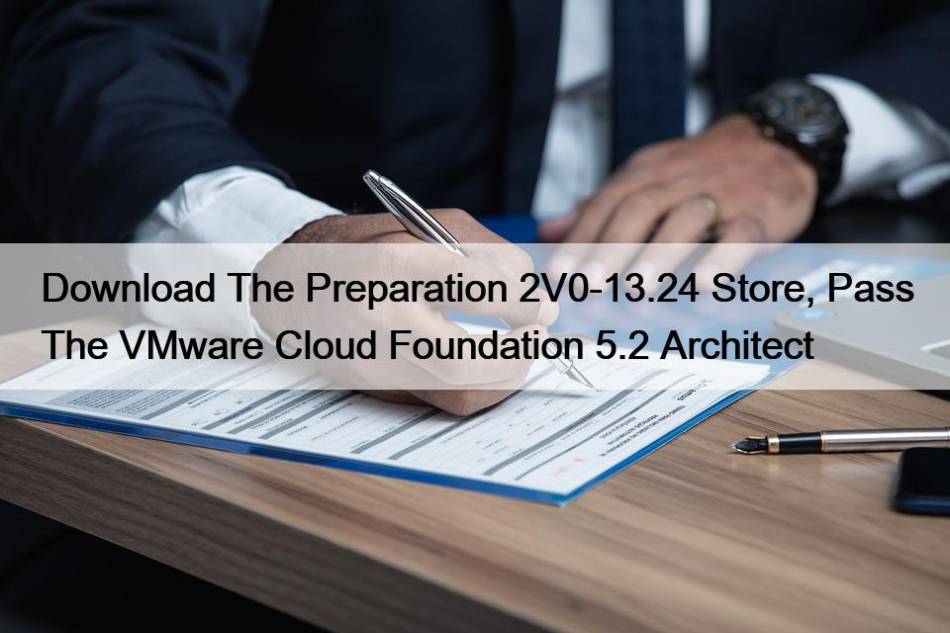Most Popular
 Microsoft - AZ-900–Reliable Valid Test Labs
Microsoft - AZ-900–Reliable Valid Test Labs
BONUS!!! Download part of Pass4cram AZ-900 dumps for free: https://drive.google.com/open?id=1NpTEqiDTiSDiEgP_bhXK4QAOoIkh9Wj0We ...
 100% Pass Quiz Unparalleled Certification 1Z0-1085-25 Test Answers: Valid Exam Oracle Cloud Infrastructure 2025 Foundations Associate Book
100% Pass Quiz Unparalleled Certification 1Z0-1085-25 Test Answers: Valid Exam Oracle Cloud Infrastructure 2025 Foundations Associate Book
This is an era of high efficiency, and how to ...
 Download The Preparation 2V0-13.24 Store, Pass The VMware Cloud Foundation 5.2 Architect
Download The Preparation 2V0-13.24 Store, Pass The VMware Cloud Foundation 5.2 Architect
The candidates all enjoy learning on our 2V0-13.24 practice exam ...



Download The Preparation 2V0-13.24 Store, Pass The VMware Cloud Foundation 5.2 Architect

The candidates all enjoy learning on our 2V0-13.24 practice exam study materials. Also, we have picked out the most important knowledge for you to learn. The difficult questions of the 2V0-13.24 study materials have detailed explanations such as charts, illustrations and so on. We have invested a lot of efforts to develop the 2V0-13.24 Training Questions. Please trust us. You absolutely can understand them after careful learning.
VMware 2V0-13.24 Exam Syllabus Topics:
| Topic | Details |
|---|---|
| Topic 1 |
|
| Topic 2 |
|
| Topic 3 |
|
| Topic 4 |
|
| Topic 5 |
|
>> Preparation 2V0-13.24 Store <<
Updated Preparation 2V0-13.24 Store - Find Shortcut to Pass 2V0-13.24 Exam
The marketplace is competitive, especially for securing a well-paid job. Moving your career one step ahead with 2V0-13.24 certification will be a necessary and important thing. How to get the 2V0-13.24 exam dumps with 100% pass is also important. VMware 2V0-13.24 training topics will ensure you pass at first time. The experts who involved in the edition of 2V0-13.24 questions & answers all have rich hands-on experience, which guarantee you the high quality and high pass rate.
VMware Cloud Foundation 5.2 Architect Sample Questions (Q97-Q102):
NEW QUESTION # 97
An architect is designing a new VMware Cloud Foundation (VCF) solution. During the discovery workshops, the customer explained that the solution will initially be used to host a single business application and some internal management tooling. The customer provided the following background information:
The business application consists of two virtual machines.
The business application is sensitive to changes in its storage I/O.
The business application must be available during the company's business hours of 9 AM - 5 PM on weekdays.
The architect has made the following design decisions in response to the customer's requirements and the additional information provided during discovery:
The solution will use the VCF consolidated architecture model.
A single cluster will be created, consisting of six ESXi hosts.
Which design decision should the architect include in the design to mitigate the risk of impacting the business application?
- A. Use Anti-Affinity Distributed Resource Scheduler (DRS) rules on the business application virtual machines.
- B. Implement FTT=6 for the business application virtual machines.
- C. Perform ESXi host maintenance activities outside of the stated business hours.
- D. Use resource pools to apply CPU and memory reservations on the business application virtual machines.
- E. Replace the vSAN shared storage exclusively with an All-Flash Fibre Channel shared storage solution.
Answer: C
Explanation:
The VCF 5.2 design must ensure the business application (two VMs) remains available during business hours (9 AM - 5 PM weekdays) and is protected from storage I/O disruptions in a consolidated architecture with a single six-host cluster using vSAN. The goal is to mitigate risks to the application's performance and availability. Let's evaluate each option:
Option A: Use resource pools to apply CPU and memory reservations on the business application virtual machinesResource pools with reservations ensure CPU and memory availability, which could help performance. However, the application's sensitivity is tostorage I/O, not CPU/memory, and the availability requirement (business hours) isn't directly addressed by reservations. While useful, this doesn't fully mitigate the primary risks identified, making it less optimal.
Option B: Implement FTT=6 for the business application virtual machinesThis is incorrect and infeasible. In vSAN, Failures to Tolerate (FTT) defines the number of host or disk failures a storage object can withstand, with a maximum FTT dependent on cluster size. FTT=6 requires at least 13 hosts (2n+1 where n=6), but the cluster has only six hosts, supporting a maximum FTT=2 (RAID-5/6). Even if feasible, FTT addresses data redundancy, not runtime availability or I/O sensitivity during business hours, making this irrelevant to the stated risks.
Option C: Perform ESXi host maintenance activities outside of the stated business hoursThis is the correct answer. In a vSAN-based VCF cluster, ESXi host maintenance (e.g., patching, reboots) triggers data resyncs and VM migrations (via vMotion), which can impact storage I/O performance and potentially cause brief disruptions. The application's sensitivity to storage I/O and its availability requirement (9 AM - 5 PM weekdays) mean maintenance during business hours poses a risk. Scheduling maintenance outside these hours (e.g., nights or weekends) mitigates this by ensuring uninterrupted I/O performance and availability during critical times, directly addressing the customer's needs.
Option D: Replace the vSAN shared storage exclusively with an All-Flash Fibre Channel shared storage solutionThis is incorrect. While an All-Flash Fibre Channel array might offer better I/O performance, VCF's consolidated architecture relies on vSAN as the primary storage for management and workload domains.
Replacing vSAN entirely contradicts the chosen architecture and introduces unnecessarycomplexity and cost.
The sensitivity to storage I/O changes doesn't justify abandoning vSAN, especially since All-Flash vSAN could meet performance needs if properly tuned.
Option E: Use Anti-Affinity Distributed Resource Scheduler (DRS) rules on the business application virtual machinesAnti-Affinity DRS rules ensure the two VMs run on separate hosts, improving availability by avoiding a single host failure impacting both. While this mitigates some risk, it doesn't address storage I/O sensitivity (a vSAN-wide concern) or guarantee availability during business hours if maintenance occurs. It's a partial solution but less effective than scheduling maintenance outside business hours.
Conclusion:The best design decision is toperform ESXi host maintenance activities outside of the stated business hours(Option C). This directly mitigates the risk of storage I/O disruptions and ensures availability during 9 AM - 5 PM weekdays, aligning with the customer's requirements in the VCF 5.2 consolidated architecture.
References:
VMware Cloud Foundation 5.2 Architecture and Deployment Guide (Section: Consolidated Architecture Design) VMware vSAN 7.0U3 Planning and Deployment Guide (integrated in VCF 5.2): Maintenance Mode Considerations VMware Cloud Foundation 5.2 Planning and Preparation Guide (Section: Availability and Performance Design)
NEW QUESTION # 98
Which design decision helps ensure optimal performance in a VCF environment?
Response:
- A. Using multiple Availability Zones to distribute workloads evenly
- B. Configuring resource pools to limit CPU and memory consumption
- C. Utilizing a shared storage solution for all VCF components
- D. Implementing a centralized logging system for performance monitoring
Answer: A
NEW QUESTION # 99
Which VMware Cloud Foundation architecture option is best suited for organizations requiring the highest levels of availability, fault tolerance, and minimal downtime?
Response:
- A. VMware Cloud Foundation in a multi-cloud environment
- B. VMware Cloud Foundation with stretched clusters
- C. VMware Cloud Foundation with centralized storage
- D. VMware Cloud Foundation on a single site with multiple hosts
Answer: B
NEW QUESTION # 100
Which of the following should be part of the logical design when creating a VMware Cloud Foundation Workload Domain?
Response:
- A. The expected workload types and their resource consumption
- B. The specific models of ESXi hosts used in the domain
- C. The placement of physical network equipment in the data center
- D. The configuration of storage devices for the domain
Answer: A
NEW QUESTION # 101
During a requirements gathering workshop, several Business and Technical requirements were captured from the customer. Which requirement is classified as a Technical Requirement?
- A. Reduce system processing time for service requests by 25%.
- B. Expand market reach to include new geographical regions.
- C. Increase customer satisfaction by 15%.
- D. The system must support 5,000 concurrent users.
Answer: D
Explanation:
In VMware Cloud Foundation (VCF) architecture, requirements are categorized as Business or Technical based on their focus. Technical requirements specify measurable system capabilities or constraints, directly influencing design decisions for infrastructure components like compute, storage, or networking. Business requirements, conversely, focus on organizational goals or outcomes that IT supports. Option B, "The system must support 5,000 concurrent users," is a technical requirement because it defines a specific system capacity metric (concurrent users), which directly impacts scalability and resource allocation in VCF design, such as the sizing of workload domains or NSX configurations. Option A, "Reduce system processing time for service requests by 25%," could be technical but is often a derivative of a business goal (efficiency), making it less explicitly technical in this context. Options C and D, focusing on customer satisfaction and market reach, are clearly business-oriented, tied to organizational outcomes rather than system specifications.
NEW QUESTION # 102
......
Our company is a professional certification exam materials provider, we have occupied in the field for years, and therefore we have abundant experiences. In addition, 2V0-13.24 exam torrent is high quality and accuracy, for a professional team are collecting and researching the latest information for the exam. We also pass guarantee and money back guarantee for 2V0-13.24 Exam Materials, if you fail to pass the exam, we will give you full refund, and the money will be returned to your payment account. We have online and offline service, and if you have any questions for 2V0-13.24 exam braindumps, you can consult us.
Reliable 2V0-13.24 Braindumps Book: https://www.torrentvce.com/2V0-13.24-valid-vce-collection.html
- VMware 2V0-13.24 Unparalleled Preparation Store Pass Guaranteed Quiz 🍍 ( www.getvalidtest.com ) is best website to obtain ➡ 2V0-13.24 ️⬅️ for free download 🚠2V0-13.24 Exam Pass4sure
- The best way to Prepare Exam With VMware 2V0-13.24 Exam Dumps 🚒 Search for ( 2V0-13.24 ) on ➥ www.pdfvce.com 🡄 immediately to obtain a free download 🎿Free 2V0-13.24 Practice
- 2V0-13.24 Trustworthy Pdf 📤 Valid Test 2V0-13.24 Fee 🏂 2V0-13.24 Trustworthy Pdf 🔤 Search for { 2V0-13.24 } and download exam materials for free through { www.prep4sures.top } 😈2V0-13.24 Authentic Exam Questions
- The best way to Prepare Exam With VMware 2V0-13.24 Exam Dumps 🛸 Easily obtain free download of ⏩ 2V0-13.24 ⏪ by searching on 「 www.pdfvce.com 」 😀Braindumps 2V0-13.24 Downloads
- Braindumps 2V0-13.24 Downloads 💨 Top 2V0-13.24 Dumps 🖱 2V0-13.24 Exam Pass4sure 😕 Search for 《 2V0-13.24 》 on ▶ www.real4dumps.com ◀ immediately to obtain a free download ⏬Test 2V0-13.24 Tutorials
- 2V0-13.24 Accurate Prep Material 🥢 Top 2V0-13.24 Dumps 👐 2V0-13.24 Accurate Prep Material 🌌 Search for ▶ 2V0-13.24 ◀ and obtain a free download on ⏩ www.pdfvce.com ⏪ 🐟2V0-13.24 Latest Exam Cram
- 2V0-13.24 Study Materials - 2V0-13.24 Premium VCE File - 2V0-13.24 Exam Guide 🍑 Search on ( www.torrentvce.com ) for ➡ 2V0-13.24 ️⬅️ to obtain exam materials for free download 🈺Reliable 2V0-13.24 Exam Review
- Free PDF 2025 VMware 2V0-13.24: High Pass-Rate Preparation VMware Cloud Foundation 5.2 Architect Store 🤜 Search for ➤ 2V0-13.24 ⮘ on 「 www.pdfvce.com 」 immediately to obtain a free download 🖕2V0-13.24 Cert
- 2025 Latest Preparation 2V0-13.24 Store | 100% Free Reliable VMware Cloud Foundation 5.2 Architect Braindumps Book 📥 The page for free download of ➠ 2V0-13.24 🠰 on ⏩ www.prep4away.com ⏪ will open immediately ◀2V0-13.24 Trustworthy Pdf
- Test 2V0-13.24 Tutorials 👯 2V0-13.24 Authentic Exam Questions 🛩 Top 2V0-13.24 Dumps 📆 Search for ☀ 2V0-13.24 ️☀️ and obtain a free download on { www.pdfvce.com } ⭕2V0-13.24 Exam Pass4sure
- 2V0-13.24 Testking Exam Questions ❎ Valid Braindumps 2V0-13.24 Files 🚬 2V0-13.24 Latest Exam Cram 🧩 Copy URL ➠ www.examsreviews.com 🠰 open and search for ( 2V0-13.24 ) to download for free 🐛2V0-13.24 Testking Exam Questions
- 2V0-13.24 Exam Questions
- examkhani.com iobrain.in www.capetownjobs.co.za transformlms.techlogiclk.com msidiomas.com madonnauniversityskills.com.ng channel.yogalaurent.com iban天堂.官網.com glowegacademy.com sophiam889.bloggosite.com
Tags: Preparation 2V0-13.24 Store, Reliable 2V0-13.24 Braindumps Book, New 2V0-13.24 Test Dumps, Test 2V0-13.24 Simulator, Top 2V0-13.24 Dumps